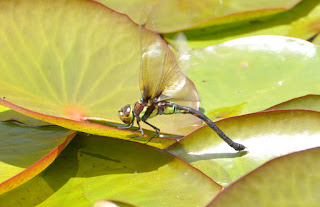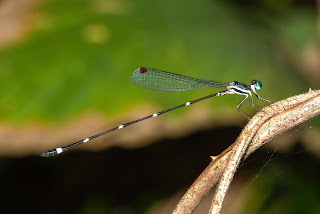 |
| Martin’s Duskhawker (Anaciaeschna martini) |
Dragonflies & Damselflies belong to the group
called Odonates. These insects are prime ecological indicators. Serious study
of Odonates of the Western Ghats has gained momentum only recently, to be
precise since the early part of the last decade. Apart from the scientific community, citizen
science initiatives are also now on to identify and conserve these little-known
fauna of our region. Thus, it was on the Odonates of Western Ghats Facebook
group discussion between Dr. Kalesh Sadasivan, an avid naturalist from the Travancore
Nature History Society (TNHS), Trivandrum, Kerala and Manoj Sethumadhavan from
the Wynter-Blyth Association (WBA), The Nilgiris, the surprising fact that one species which was
described in 1922 had not been sighted in south India ever since has sprung to
light. The last record of the three species
was by F.C. Fraser in 1933 from Anamalai Hills and another described in 1958
was sighted in Agasthyamalais and Kakkayam.
 |
| Kimmin’s Reed tail (Protosticta rufostigma) |
Martin’s Duskhawker (Anaciaeschna martini) belongs to the family Aeshnidae which are generally large dragonflies known for their fast majestic flight. Lt. Col.Frederick Charles Fraser (15 Feb 1880 - 02 Mar 1963) an English entomologist who specialized in Odonata, who was a surgeon of the Indian Medical Service during pre-independence days, has done tremendous work on Indian Odonata. He was also a fellow of the Royal Entomological Society. His works on Indian Odonata were published in 1924-1931 and also two volumes in Fauna of British India published in 1933, 1934 & 1936. Fraser (1922) described Anaciaeschna donaldi Kodaikanal (Palni hills). It is a large dragonfly with dark olivaceous brown eyes, dark brown prothorax, and maroon with apple green marks on the thorax. Its abdomen is dark brown with apple green marks on the first three segments and pale yellowish-brown marks on the sides of segments four to seven. According to Fraser, they are found in diverse wetland habitats from the coast to high altitude montane lakes. Most are diurnal, though some are crepuscular species and distributed globally.
According to Dr Kalesh, the males are virtually never encountered in the field, while the females are seen during ovipositing on emergent aquatic vegetation. Manoj Sethumadavan opines that the breeding season observed was from May to November tallying with the monsoon rains in the region. The species is a strong flyer and hence may be expected to be found across similar mountainous locations with suitable habitats in Peninsular India as commented recently by experts in the field. The status of the species is possibly locally ‘not uncommon’ but maybe rare altogether in the Western Ghats. Further studies may be done to elucidate the status and distribution of the species along with those odonates occupying the montane lakes of Western Ghats, as an indicator of the rapidly changing environmental conditions of this threatened mountain ecosystem- a biodiversity hotspot.
The team has published their work in the Journal of Threatened Taxa as two research papers. The first paper is the result of collaborative work by TORG (TNHS Odonate Research Group) with the Wynter-Blyth Association, Nilgiris, and the second by TORG with Zoological Survey of India. Students of Odonata may contact Dr. Kalesh (kaleshs2002in@gmail.com) or Mr Manoj Sethumadhavan(wba.nilgiris@gmail.com) for further information.



No comments:
Post a Comment